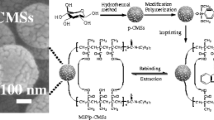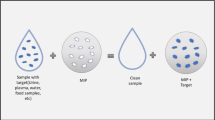Abstract
Several molecularly imprinted polymers (MIPs) for the retention of 4,6-dimethyldibenzothiophene (4,6-DMDBT) were prepared. The first was a polymer prepared non-covalently with methacrylic acid and ethylene glycol dimethacrylate polymerized in the presence of 4,6-DMDBT. After extraction of 4,6-DMDBT, the selectivity of the imprinted polymer was evaluated by HPLC and compared to a non-imprinted control polymer prepared without 4,6-DMDBT. The imprinted polymer retained 4,6-DMDBT slightly longer than the control polymer. The second polymer was prepared using nickel (II)-methacryloylhistidinedihydrate monomer which was combined with 4,6-DMDBT, and polymerized with ethylene glycol dimethacrylate. This is a novel use of this monomer for retention of sulfur-containing organic compounds. Selectivity for 4,6-DMDBT was much greater in this polymer compared to the first, and retention in acetonitrile was more than three times greater on the imprinted polymer compared to a control polymer. Results indicate the potential use of this novel MIP for the removal of organosulfur compounds from fuel.

Chromatograms of a solution of acetone and 10 ppm 4,6-DMDBT in acetonitrile, evaluated on a non-imprinted control (dashed line) and imprinted test (solid line) polymers. Peak at 1.5 min on control column are acetone and 4,6-DMDBT. Peak at 1.5 min on test column is acetone and at 2.5 min is 4,6-DMDBT.


Similar content being viewed by others
References
Kilbane J II (2006) Microbial biocatalyst developments to upgrade fossil fuels. Curr Opin Biotechnol 17:305
Ito E, Rob van Veen JA (2006) On novel processes for removing sulphur from refinery streams. Catal Today 116:446
Guobin S, Huaiying Z, Jianmin X, Guo C, Wangliang L, Huizhou L (2006) Biodesulfurization of hydrodesulfurized diesel oil with Pseudomonas delafieldii R-8 from high density culture. Biochem Eng J 27:305
Dai Y, Qi Y, Zhqo D, Zhang H (2008) Desulfurization of transportation fuels targeting at removal of thiophene/benzothiophene. Fuel Process Technol 89:749
Dai W, Zhou Y, Wang S, Su W, Sun Y, Zhou L (2008) An oxidative desulfurization method using ultrasound/Fenton's reagent for obtaining low and/or ultra-low sulfur diesel fuel. Fuel Process Technol 89:927
Sellergren B, Hall A (2001) Fundamental aspects on the synthesis and characterization of imprinted network polymers. In: Sellergren B (ed) Molecularly imprinted polymers, man-made mimics of antibodies and their applications in analytical chemistry. Elsevier, Amsterdam, pp 21–55
Sellergren B (1998) Important considerations in the design of receptor sites using noncovalent imprinting. In: Bartsch R, Maeda M (eds) Molecular and ionic recognition with imprinted polymers. Oxford University Press, Washington, pp 49–80
Castro B, Whitcombe M, Vulfson E, Vazquez-Duhalt R, Barzana E (2001) Molecular imprinting for the selective adsorption of organosulphur compounds present in fuels. Anal Chim Acta 435:83
Chang Y, Zhang L, Ying H, Li Z, Lv H, Ouyang P (2010) Desulfurization of gasoline using molecularly imprinted chitosan as selective adsorbents. Appl Biochem Biotechnol 160:593
Xu P, Xu W, Zhang X, Yan Y (2010) A surface-imprinted polymer for removing dibenzothiophene from gasoline. Microchim Acta 171:441
Xu W, Zhou W, Huang W, Pan J, Li H, Wu X, Yan Y (2011) Preparation and evaluation of a novel surface-imprinted polymer for selective adsorption of dibenzothiophene. Microchim Acta 175:167
Ma X, Sprague M, Song C (2005) Deep desulfurization of gasoline by selective adsorption over nickel-based adsorbent for fuel cell applications. Ind Eng Chem Res 44:5768
Hernandez S, Solarino L, Orsello G, Russo N, Fino D, Saracco G, Specchia V (2008) Desulfurization processes for fuel cells systems. Int J of Hydrogen Energ 33:3209
Richard F, Boita T, Perot G (2007) Reaction mechanism of 4,6-dimethyldibenzothiophene desulfurization over sulfided NiMoP/Al2O3-zeolite catalysts. Appl Catal A.: Gen 320:69
Shu Y, Oyama ST (2005) A new type of nonsulfide hydrotreating catalyst: nickel phosphide on carbon. Chem Commun :1143–1145. doi:10.1039/b415838e
Ko CH, Park JG, Park JC, Song H, Han SS, Kim JN (2007) Surface status and size influences of nickel nanoparticles on sulfur compound adsorption. Appl Surf Sci 253:5864
Gichinga MG, Streigler S, Dunaway NA, Barnett JD (2010) Miniemulsion polymers as solid support for transition metal catalysts. Polymer 51:606
Ersöz A, Say R, Denizli A (2004) Ni(II) ion-imprinted solid-phase extraction and preconcentration in aqueous solutions by packed-bed columns. Anal Chim Acta 502:91
Nicholls I, Andersson H (2000) Thermodynamic principles underlying molecularly imprinted polymer formulation and ligand recognition. Tech Instr in Anal Chem 23:59
Lele BS, Kulkarni MG, Mashelkar RA (1999) Molecularly imprinted polymer mimics of chymotrypsin 1. Cooperative effects and substrate specificity. React Funct Polym 29:37
Say R, Ersoz A, Turk H, Denizli A (2004) Selective separation and preconcentration of cyanide by a column packed with cyanide-imprinted polymeric microbeads. Separ Purif Technol 40:9
Bhandari VM, Ko CH, Park JG, Han SS, Cho SH, Kim JN (2006) Desulfurization of diesel using ion-exchanged zeolites. Chem Eng Sci 61:2599
Spivak D, Campbell J (2001) Systematic study of steric and spatial contributions to molecular recognition by non-covalent imprinted polymers. Analyst 126:793
Dauwe C, Sellergren B (1996) Influence of template basicity and hydrophobicity on the molecular recognition properties of molecularly imprinted polymers. J Chromatogr A 753:191
Acknowledgement
We are grateful to Susquehanna University for funding and supporting this project.
Author information
Authors and Affiliations
Corresponding author
Rights and permissions
About this article
Cite this article
Tom, L.A., Gerard, C.L., Hutchison, C.M. et al. Development of a novel molecularly imprinted polymer for the retention of 4,6-dimethyldibenzothiophene. Microchim Acta 176, 375–380 (2012). https://doi.org/10.1007/s00604-011-0730-0
Received:
Accepted:
Published:
Issue Date:
DOI: https://doi.org/10.1007/s00604-011-0730-0




